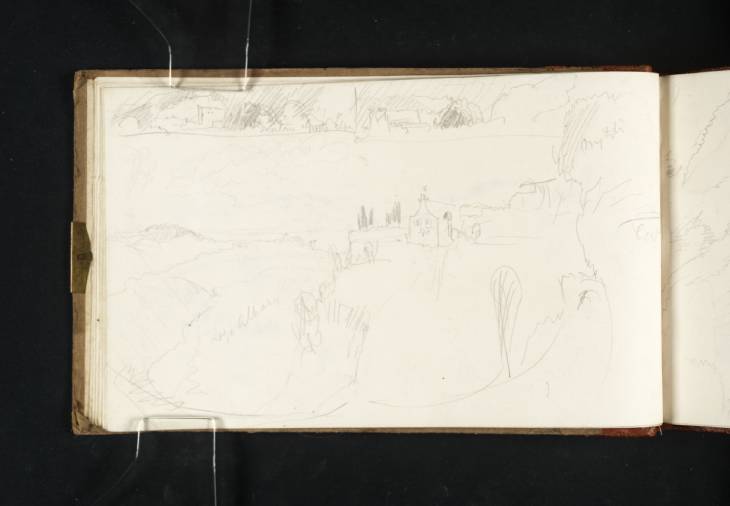Joseph Mallord William Turner Lake Albano and the Monastery of Palazzola; and Two Sketches of a Cave, possibly the Fountain of Aqua Ferentina 1819
Image 1 of 2
-
 Joseph Mallord William Turner, Lake Albano and the Monastery of Palazzola; and Two Sketches of a Cave, possibly the Fountain of Aqua Ferentina 1819
Joseph Mallord William Turner, Lake Albano and the Monastery of Palazzola; and Two Sketches of a Cave, possibly the Fountain of Aqua Ferentina 1819 -
 Joseph Mallord William Turner, Lake Albano and the Monastery of Palazzola; and Two Sketches of a Cave, possibly the Fountain of Aqua Ferentina 1819 (Enhanced image)Enhanced image
Joseph Mallord William Turner, Lake Albano and the Monastery of Palazzola; and Two Sketches of a Cave, possibly the Fountain of Aqua Ferentina 1819 (Enhanced image)Enhanced image
Joseph Mallord William Turner,
Lake Albano and the Monastery of Palazzola; and Two Sketches of a Cave, possibly the Fountain of Aqua Ferentina
1819
Joseph Mallord William Turner 1775–1851
Folio 8 Verso:
Lake Albano and the Monastery of Palazzola; and Two Sketches of a Cave, possibly the Fountain of Aqua Ferentina 1819
D15310
Turner Bequest CLXXXII 8 a
Turner Bequest CLXXXII 8 a
Pencil on white wove paper, 113 x 189 mm
Inscribed by the artist in pencil ‘Lago Albano’ within sketch of lake and ‘Fountain Grotto Alba’ beneath sketch top left and ‘Myth’ top right
Accepted by the nation as part of the Turner Bequest 1856
References
1909
A.J. Finberg, A Complete Inventory of the Drawings of the Turner Bequest, London 1909, vol.I, p.536, as ‘Three sketches; one of “Lago Albano”, and another of the “Fountain, Grotto Alba” ’.
1974
Gerald Wilkinson, The Sketches of Turner, R.A. 1802–20: Genius of the Romantic, London 1974, reproduced p.186 bottom, as ‘Lago Albano’.
1977
Gerald Wilkinson, Turner Sketches 1789–1820, London 1977, p.[158], reproduced p.156 bottom, as ‘Lago Albano’.
1979
Andrew Wilton, The Life and Work of J.M.W. Turner, Fribourg 1979, p.384 no.731.
1984
Cecilia Powell, ‘Turner and the Bandits: ‘Lake Albano’ rediscovered’, Turner Studies, Summer 1984, vol.3, no.2, p.23.
1984
Cecilia Powell, ‘Turner on Classic Ground: His Visits to Central and Southern Italy and Related Paintings and Drawings’, unpublished Ph.D thesis, Courtauld Institute of Art, University of London 1984, pp.194 note 102, 196 note 110, 262 note 123.
1987
Cecilia Powell, Turner in the South: Rome, Naples, Florence, New Haven and London 1987, pp.[88] note 78, 89 note 81.
2000
David Hill, Joseph Mallord William Turner: Le Mont-Blanc et la Vallée d’Aoste, exhibition catalogue, Museo Archeologico Regionale, Aosta / Musée Archéologique Régional, Aoste 2000, p.295.
Turner explored the area around Lake Albano and made drawings from several different spots. The view in this sketch is from the eastern shore of the lake with the monastery of Palazzola on the right-hand side.1 The town of Castel Gandolfo with the dome of the Church of San Tommaso Villanova is visible on the other side of the water. Above this are two separate sketches which seem to show the dark opening of a cave amidst the hills inscribed by the artist ‘Fountain Grotto Alba’. This location has not been positively identified but one possibility is that it represents the fountain, or source, of the Aqua Ferentenia, a spring which feeds into Lake Albano. A passage in William Gell’s Topography of Rome and its Vicinity, 1846, confirms that there was also a small cave within the rock, a few yards above the fountain.2 Having made notes on the area in the Italian Guidebook Sketchbook (see Tate D13952; Turner Bequest CLXXII 11a) Turner was clearly familiar with Eustace’s description in A Classical Tour Through Italy:
Nothing can be more delightful than the walks around the lake, sometimes approaching the edge of the steep banks and looking down upon the glassy surface extended below, and at other times traversing the thickets and woods that rise all around, and refresh the traveller as he passes under their vast contiguity of shade. Another umbrageous alley, partly through woods, leads to Marino, a very pretty town: the approach to it with the rocky dell, the fountain [the source of the Aqua Ferentina] in the midst, the town on the eminence above, the woods below and on the side of the road, might furnish an excellent subject for a landscape.3
For a full discussion of Turner’s depictions of Lake Albano see folio 3 verso (D15301) and the general introduction to the sketchbook.
Nicola Moorby
May 2008
See a drawing of a similar view by Charles Joseph Lecointe, see Francesco Petrucci e Susanna Marra, Vedute dei Colli Albani e di Roma dall’album di viaggio di Charles Joseph Lecointe (1824–1886), exhibition catalogue, Palazzo Chigi, Ariccia 2006, no.15, p.33, reproduced.
How to cite
Nicola Moorby, ‘Lake Albano and the Monastery of Palazzola; and Two Sketches of a Cave, possibly the Fountain of Aqua Ferentina 1819 by Joseph Mallord William Turner’, catalogue entry, May 2008, in David Blayney Brown (ed.), J.M.W. Turner: Sketchbooks, Drawings and Watercolours, Tate Research Publication, December 2012, https://www

